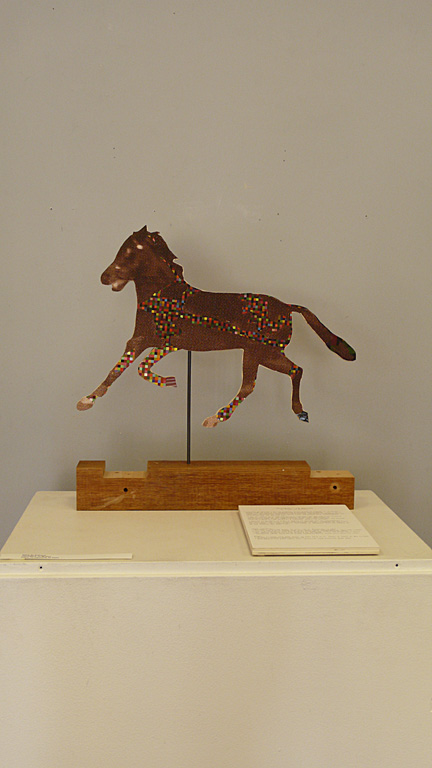 |
Image
contents: -“Occident” trotting right to left , by E. Muybridge, c.1877 - Outline and pixels drawn from “Occident” image reproduced in “Time Stands Still,” exhibit catalogue, Cantor Museum, 2003. - Sky and live oaks over the stables at Stanford; steps for mounting a horse - jpeg images taken with Leica D-Lux 3 on 10/16/08. - Composite image printed on Epson Enhanced Matte paper with archival inks. Mount: - Birch plywood from Home Depot in East Palo Alto, sawed to shape by Max Citron at Stanford’s product realization lab. - Old-growth fir work table leg - recycled from Stanford wood shop, cut to specs at Stanford's sculpture lab. |
Eadweard Muybridge’s motion studies, which began in earnest at Stanford’s horse farm in Palo Alto, represented a notable breakthrough toward instantaneous photography and contained the seeds of today’s movie industry. By breaking down motion into smaller components sequenced in time, then reassembling the parts at brisk pace, Muybridge also foreshadowed Taylorism and the machine age. Today we fumble with amateur digital cameras that are too slow to catch a small girl’s twirl and sudden grin. We work on computers, practically born on the same Stanford farm, that are supposed to save time but slow it down to a sludge. Our lives, online, are wasted - they have none of the grace of a physical animal in motion. I wanted to go back in time. I wanted to explore one of photography’s earliest attempts to fix lines and still motion by lingering on the image of “Occident” trotting, taken by Muybridge in 1877. I wanted to play with a horse. That cursed colt - the horse of progress that has robbed us of our seasons and down time. |
